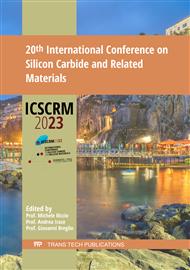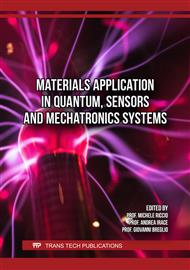p.17
p.23
p.29
p.35
p.41
p.47
p.55
p.63
p.71
Design of Monolithically Integrated Temperature Sensors in 4H-SiC JFETs
Abstract:
In this paper we study and compare two designs of a temperature sensor monolithically integrated to a vertical SiC JFET. One sensor utilizes the standard JFET P+ aluminum gate implantation scheme. The advantage of this sensor is that the integration with a JFET process flow can be achieved with no additional process steps or mask layers. The other sensor uses a combination P-body and a low energy P+ implantation scheme, typically seen in MOSFETs. Both sensors exploit the variation of resistance with temperature of Al doped SiC. Drift-Diffusion simulations of both designs are carried out at fixed temperatures, exhibiting an excellent ~53% relative reduction in sensor resistance from 300 to 450K. However, neither design shows linear behavior with temperature, beginning to saturate at 450K. Electrothermal simulations are also deployed to verify the sensor robustness as the sensor is locate relatively far from the JFET junction. Due to the high thermal conductivity of SiC, the sensor average temperature follows closely the junction temperature. Current crowding (or 2D effects) close to the contact edges is observed in both sensors. We also deploy a simple analytical model to calculate the resistance as a function of the temperature for both sensors. The model agrees with the drift-diffusion calculations, however due to the 2D nature of current flow, a maximum 19.6% relative error is obtained. In general, both sensors deployed similar relative sensitivity, however the P-body sensor resistance changes in a range of 10.6kΩ to 4.95kΩ compared to 700Ω to 330Ω for the P+ sensor.
Info:
Periodical:
Pages:
47-54
Citation:
Online since:
August 2024
Authors:
Permissions:
Share:
Citation:



